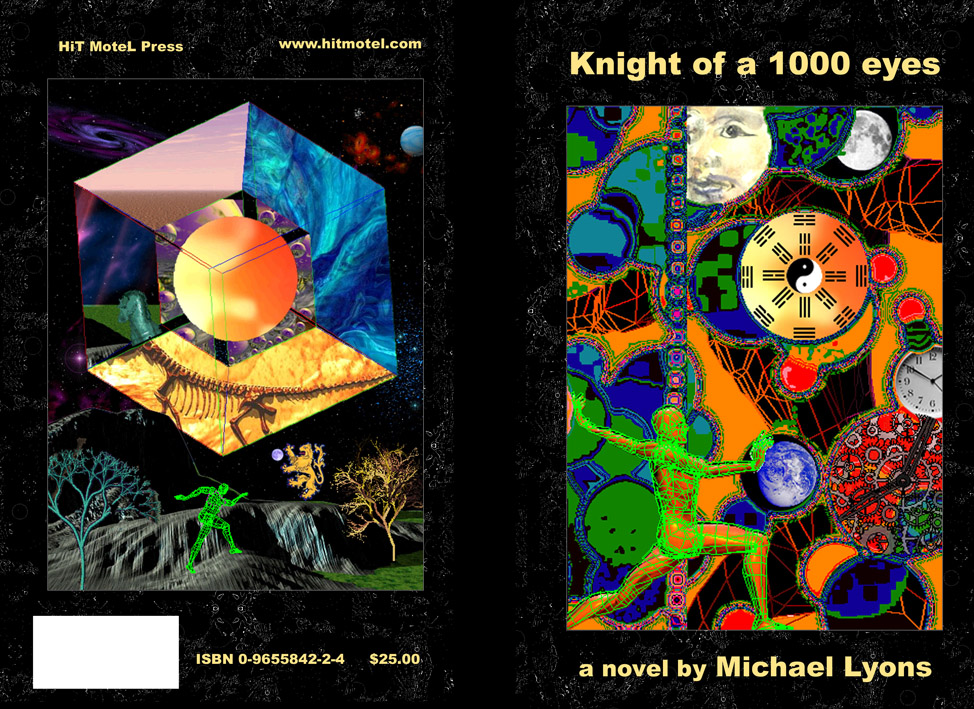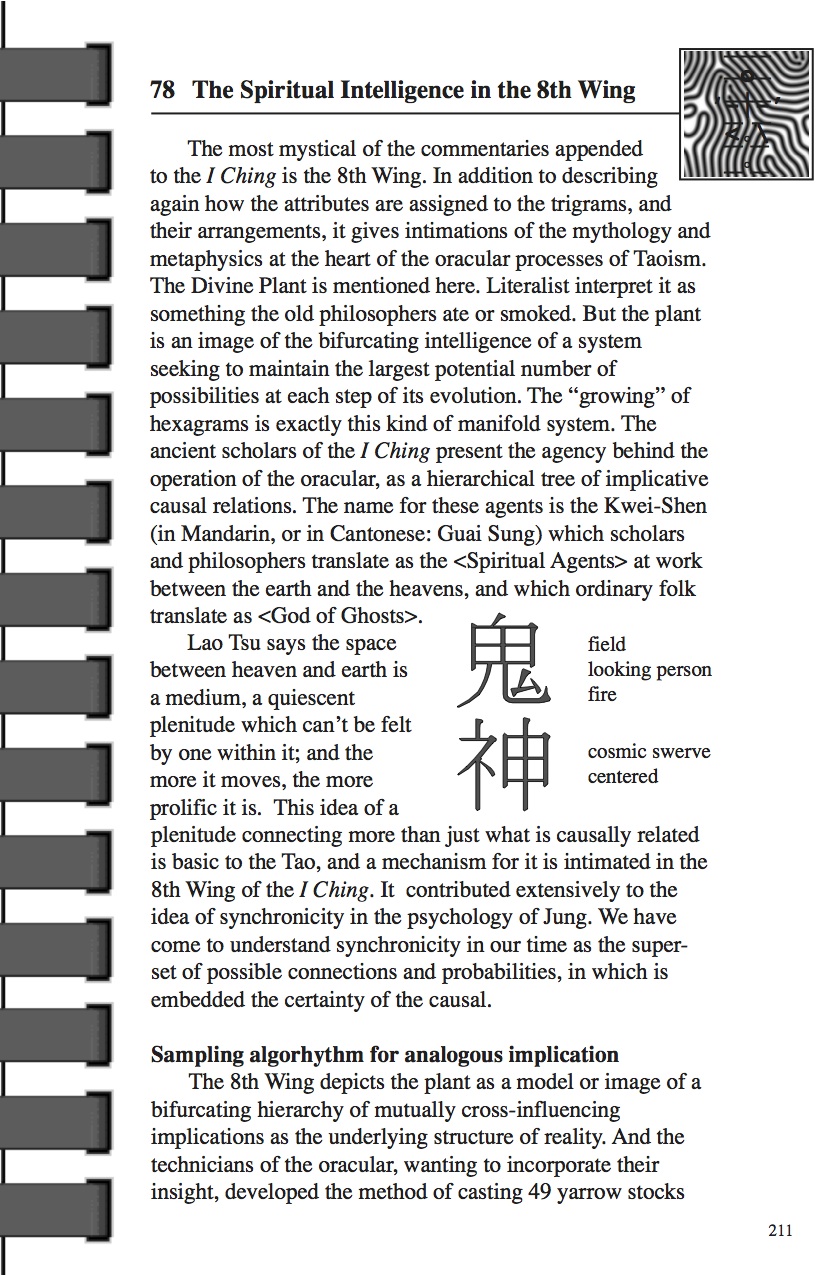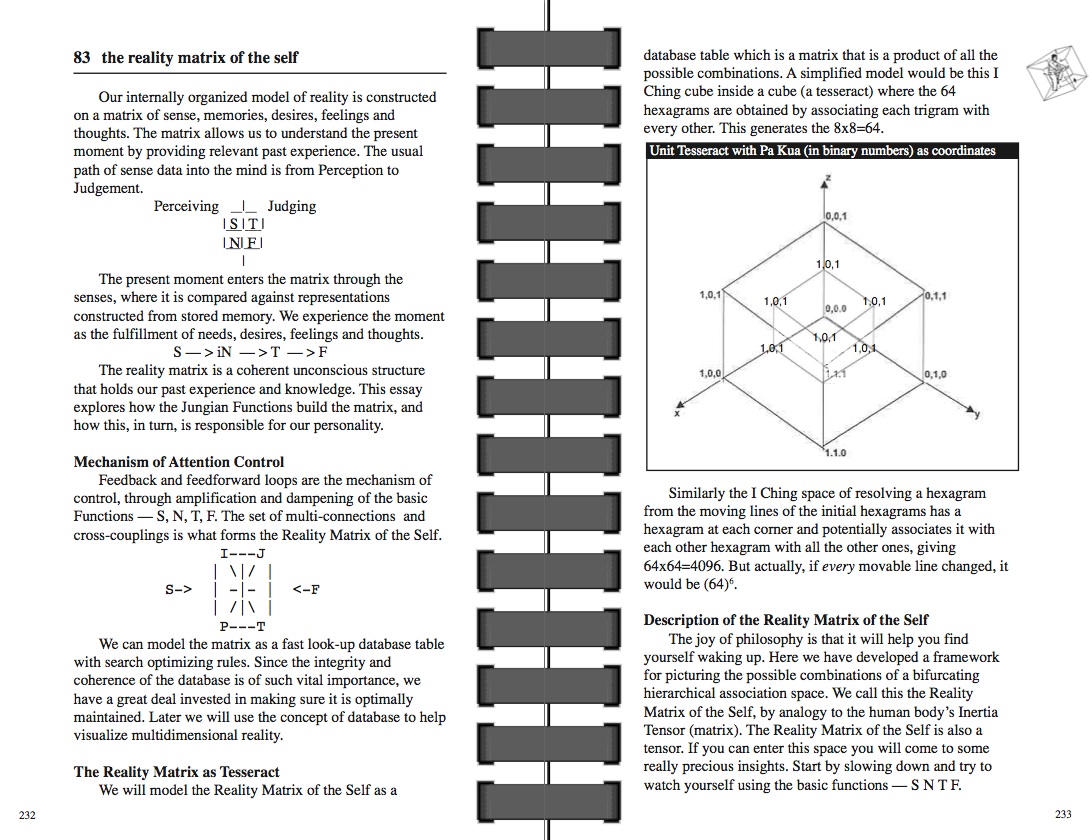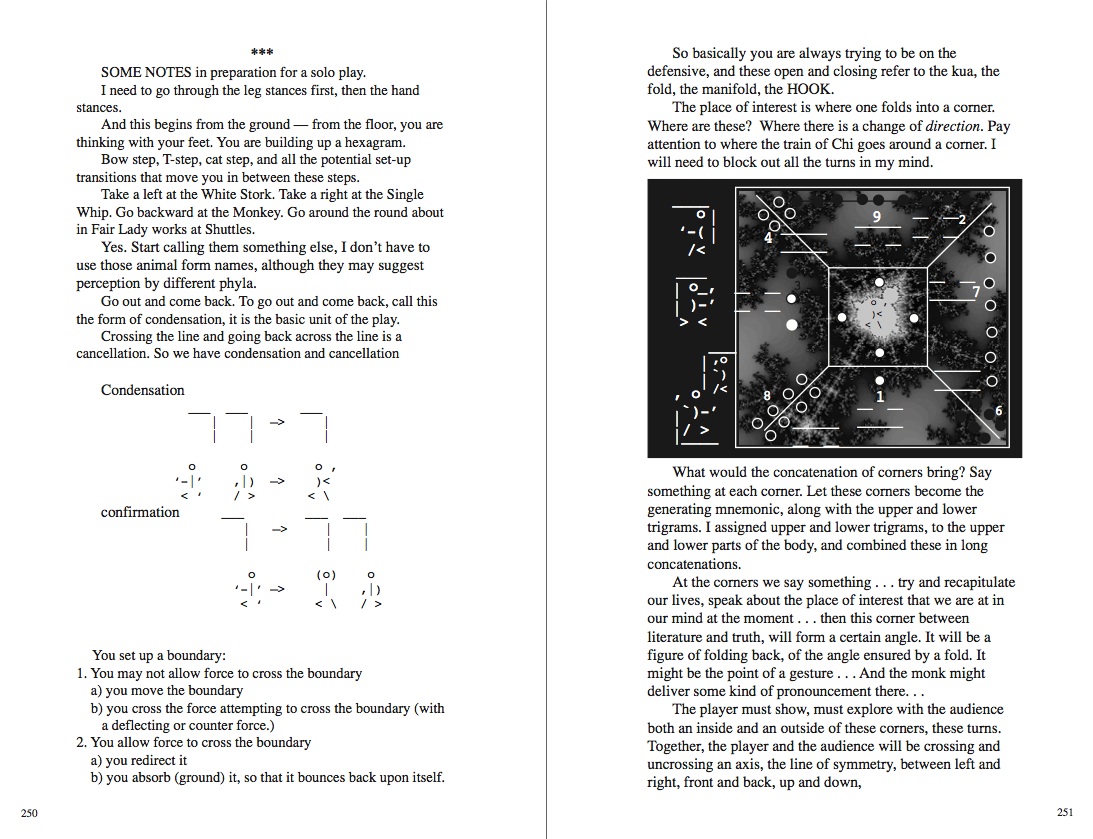Knight of a 1000 eyes
Paperback: HiT MoteL Press, December 7 2002, 1st Edtion
No epub possible, the page design in this publication is one for the books.
335 pages. Paperback ISBN 9780965584227
Buy the paperback on Amazon or Barnes & Noble.
Buy the ebook from Amazon or HiT MoteL Press.
See the other books in this sextet HiT MoteL Press.
Summary
The plot of Knight of a 1000 eyes is the journal of learning Tai Chi. It humorously shows the beginner slavishly vogueing the stances in a book. He is trying to answer the need to have security on the farm in the advent of confronting pot rustlers on the prairie. That's how it starts. The first section is Fixed Frame in which the beginner is trying to mimic the directions and conform to the Form.
The second section is Lively Frame in which the tai chi player discovers, embedded in the form, a kind of text teaching him about his physical being and further about the eternal Tao. Gravity also teaches how to use the center to move by balancing weight distribution. Equanimity in relationships and desires is also part of the study. Now the player can improvise and since he doesn’t need to think about it he can dissolve into the flow of the world.
In the third section, Changing Frame the tai chi player sees how the form leads to the Tao. (See diagram below.) It is called the path, the way, a codification of the fractal, your little strand on the web into which one is woven. The Tao is about an eastern perspective of stillness and being present to the unfolding. The idea of fractal derives from the tree (or any kind of porous membrane) that like interchanging, branching out — nature burgeoning out into and colonizing possibility. This condensation of possibilities from the flow is depicted in the permutational book, the I Ching. The path leads back to a different understanding of time and number, how these archetypes are seen from the self, as reflected in the divination systems of the I Ching. The narrator under, the tutelage of and in collaboration with a spirit guide entity he has allowed to emerge from the form, writes a new perspective on the ancient tome.
Knight of a 1000 eyes is an expanded chapter from the novel Cultivating the Texas Twister Hybrid. As such it becomes volume 3 in what is called The Little House on the Prairie trilogy. (The 2nd volume is The Secret of the Cicadas Song.) In Knight of a 1000 eyes we have another book which takes place is a very compressed time. The half hour or so it takes to do a the sequences of katas called the Long Form (Yang style) of tai chi. But is is also the long time it takes to become comfortable in your own being, and to have a feeling for the eternal Tao weaving together the world. (Time in epic poem, The Secret of the Cicadas Song is the length of a peyote trip a man undertaken by the narrator who is both a physicist and a poet is walking in the landscape as we hear the an extended internal monolog of his observations.)
These are the section art of each of the 3 sections of the book.
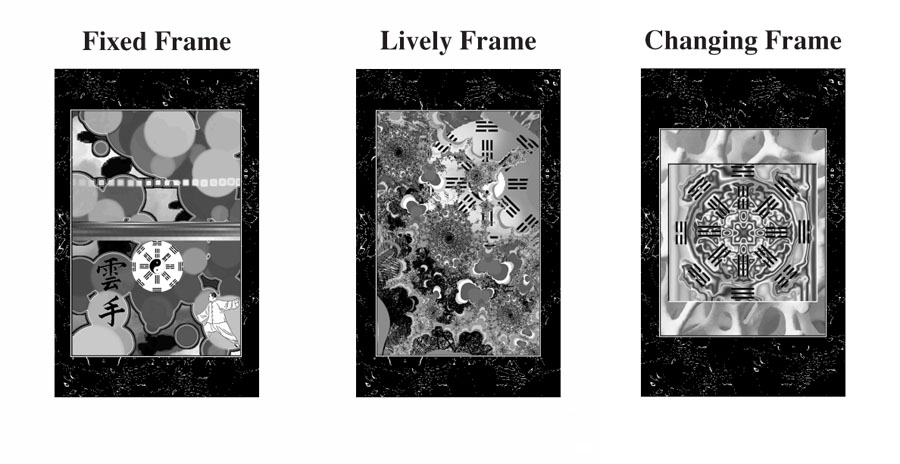
For an explanation of the frontis art for each of the three sections Fixed Frame, Lively Frame, Changing Frame click Here.
Table of Contents
I Fixed Frame
A Pot Rustler Interdiction Program 1
1 Commencement of Tai Chi, Long Form 5
2 Self 2, the criticizing Voice in your head 6
3 Yum Chi of the Phlung HI! School 8
4 Ward Off 10
5 A chop wood and haul water day 14
6 Post 15
7 Word as Object 18
8 Single Whip 19
9 Mnemonics 20
10 White Stork Spreads Wings 21
11 Chi as grace 25
12 getting high on momentum 26
13 Push Hands Solo 28
14 Sky being 30
15 Base Frequency 33
16 Sound Cadas for Solo Form 34
17 The Prettiest Word in the English Language 40
18 Laotian Tai Chi 42
19 Apparent Closure, 48
II Lively Frame
20 Carry Tiger to Mountain 51
21 Buoyancy around every being 54
22 but what has all this to do ...Chinese butt kicking 58
23 Bug 63
24 Step Back and Repulse Monkey 63
25 A fool for the Tao 64
26 Dog Bite Enlightenment 65
27 Slantingly Flying 67
28 Me and Lao Tsu 73
29 stillness in motion (key concept) 77
30 Somatic Intelligence User’s Guide 81
31 Three Phases of Ease 83
32 The Music of Awareness 87
33 How to Approach Tai Chi 91
34 The Human Body Inertia Tensor 94
35 Shifting Attention and Point of view 97
36 Wave Hands Like Clouds 98
37 blocks and grabs in wave hands like clouds 100
38 Slipped disc enlightenment 101
39 squat down 103
40 The Tao is Gravity 105
41 Contact 113
42 Yum Chi seizes me and we enter the Tao 117
43 On a Pelvis Bone in a Painting by Georgia O’Keefe 119
44 The Driving Leg 120
44 Animal Forms and Damage Hierarchy 121
46 What the Body Knows 122
47 space time window 125
48 lava lamp 126
49 The Song of Tai Chi 129
50 Effort and Qualities of Being 131
51 Tai Chi and Laban: Effortshape Grid 133
52 weightless in suburbia 138
53 Knight’s Walk and the Cadas of Energy Splitting 140
54 Cooking in the Night Kitchen 152
55 Second Apparent Closure 154
III Changing Frame
56 Carry Tiger to Mountain (2nd) 159
57 Some Closing Thoughts from sifu Yum Chi 163
58 your Tailbone is your rudder 165
59 Yum Chi as Hexagram generating machine 167
60 The Impetus for Deconstructing Synchronicity 171
61 Yum Chi’s Commentary on the I Ching 173
62 The Digital and the Analog Mind in the I Ching 177
63 The Prisoner of Mind 181
64 Fair Lady Works at Shuttles 185
65 beings of light 188
66 Weather Dragon (Part 1) 191
67 The Sepheroth and the Hexagram 194
68 Hsiu’s Object Inherency in trigram’s 3rd level 195
69 So much joy and pride in their children 196
70 The Cyclical and Inner-world Arangements 198
71 The I Ching in its purest form is the Pascal Triangle 200
72 Binomial Expansion 202
73 Hexagram production by coin toss method 203
74 The I Ching Mandala 204
75 a weak line in a strong place 207
76 Parsing the I Ching 209
77 The diachronic & the synchronic in the I Ching. 210
78 The Spiritual Intelligence in the 8th Wing 211
79 The Kuei-Shen 217
80 Interpreting an I Ching Mandala 222
81 Reading in all directions 226
80 the personality is an awareness hexagram 228
81 reality matrix of the self 232
84 An Image of the Unconscious Shadow 237
85 The Frog Symphony 239
86 the dichotomies 242
87 Coherence 245
86 Flow Control and the Laws of Form 246
87 Here I am and am not I 253
90 Chi is the Free Energy Available 256
91 Hexotranspiration and Onto(/)slashology 259
92 seeds are the leaves’ media 261
93 The Fractal Way 262
94 Yum Chi having a dream 265
95 Chinese Character for Dream 268
96 I saw the Hexagrams as resolution emerging 269
97 The I Ching is a bifurcating fractal Cantor Set 270
98 Fractal Epiphany 271
99 The Hexagram as Exponent of the Moment 273
100 Self-similarity in a salmon egg 278
101 the sequence of steps 279
102 Shadowboxing with the Enatiomorph ([) 280
103 Yum off of, off of, off-Broadway 294
104 in the landscape of the self 301
105 Step Up and Form Seven Stars 306
106 Weighty thoughts on a dust mote 308
107 Supernal Night 311
108 Conclusion and Grand Terminus 318
Writing Notes forKnight of a 1000 eyes from the Author
I majored in physics in college, and even though I took graduate classes in group algebras and the vector space theory of matter, I did not go on to get a Ph.D. because I realized I was not of the right stuff. I did learn to speak the language of matrix and operators, and statistical mechanics and did bother my mind with structural anthropology. We studied a lot of mechanics, and used the method of classical analogy to build operators in the quantum realms of Hilbert space. It was a great education in how to use isomophisms of abstract spaces to solve problems and inform intuition, but this is essentially the great power of the poet: analogy.
I had two primary goals in writing Knight of a 1000 eyes. First of all, I wanted to give a realistic picture of two halves of the psyche symbolized by the physicist and the poet working in complementary tandem toward a deep understanding of what we know in our time and in perennial time of being in the universe. This is done by developing analogies, or as they say in mathematics isomorphisms, between different domains by noticing similarity and identity of structure.
In Knight of a 1000 eyes, I explore several isomorphisms. Laban and I Ching. Jung Four Functions and I Ching. Tesseract and I Ching, therefore tesseract and Laban Notation and tesseract and the 4 functions of personality. All these abstract spaces are explored by the phenomenologist looking for observables. If you come to an impasse that seems insoluble you take the problem into the dual space. Work on the problem by analogy to one space then carry the insights gained therein back into the original space. This reasoning by classical analogy worked well in quantum mechanics, moving from the objects a continuum calculus undergoing change to operators as matrices collecting observables of data projecting through structure. This idea would become structuralism in anthropology.
As well as drawing on my experiences with physics and poetry, Knight of a 1000 eyes incorporates material that I picked up in 1975-76, when I lived in the Hawkeye theatre warehouse in Berkeley. While I was there, I studied tai chi and physical theatre from great teachers O’Keefe, Schein, Ernst, Wilson. Then on my own from the book by Da Liu while on the farm. Da Liu does the map up to I Ching and somewhat into Taoism. Laban and Jung found their way into my mind along with a long-time writers obsession with time and a physicists curiosity obsession, possession about the tesseract —a gift from the the realm of the archetypes. All this sorted itself into a perfect fit for Knight of a 1000 eyes.
My second goal in writing Knight of a 1000 eyes was to understand the perennial philosophy of Taoism especially its ability to bring the mind into the now, and its most strange and dramatic book the I Ching and its sense of number and the oracular. It is amazing to think that one could get insight by sampling some kind of synchronicity; the hexagrams matrix were like quantum matrix representation of operators to precipitate out observables about the nature of our world. The idea is that most natural processes are unfolding in an anthropic universe where we are meant to be here as an evolution of matter, and things are fitting together in harmonic phases like the wave picture of the orbitals of molecules. It is like a fractal but much more vast than anything we could know, but something we are given an intimation of sometimes that we call Tao.
Functor Diagram pulling together some of these considerations:
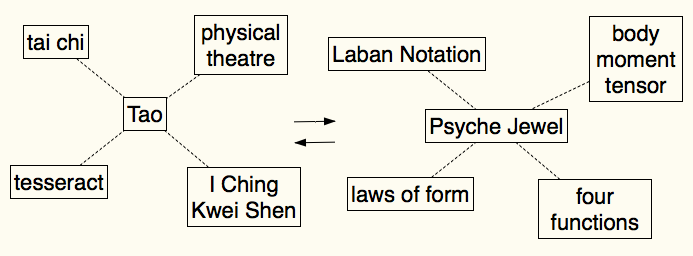
Knight of a 1000 eyes presents some phenomenological forays into trying to see into the 4th dimension. I was being visited by that great archetype and didn’t have the concepts to talk about it, or understand it. Ideas from great writers were floating out there in the air, in the noosphere and looking for someone to visit themselves upon. I am so grateful for the discipline of literary work. The tesseract is such a space time jewel, an archetype, a mandala shimmering and shifting about its 3 axes of space and one axis of time.
The idea of the 4th dimension that was used so elegantly by Einstein and Minkowski so they could do geometry in space-time bothered my mind. The idea of the 4 dimensional light cone, the edge of which was the speed of light, and anything outside the speed of that signal could not be influenced by causality; while inside the light cone occasions could be touched by the moving hand. Minkowski space was like a Euclidian geometry of 4-space and it was something you could talk to people and reach agreement on. They had the distance in 3 space and they have the distance in time (ict)^2. It was so cool you have with the use of the imaginary number “i” that time is a dimension perpendicular to space and that worked out. With finite c we understood then that everything we experience is in the past.
But beyond the light cone of relativity I did bother my writer’s mind with considerations of time. As Proust showed us there is a lot more to time. It is about becoming. Coming from possibility into probability into prophecy.
The simplest object in the 4th dimension is the tesseract. It is in 4D what the cube is in 3D. But unlike the cube we are not privileged to see it in the mind’s eye. If you became a student of the 4th dimension you had to try to see it by analogy to how you hovered in three dimensions over the flatland of the stick figures and Euclidean geometry in the plane of the page. Where 3D was projected down onto the 2D page. But now you had to go the other way and pull back to this almost god-like perspective expanded out and aggrandized into a 4th dimension perpendicular to our world, a kind of gigantic hyperocean perhaps, as Einstein once suggested, a hypersphere, curved by the presence of mass. In this world we lived on a surface and just as we could easily see inside the containers and the bodies of the beings in Flatland, god or some deity could naturally see inside our rooms as they sat in space or our bodies as they unfolded in time and space. The tesseract is an archetype of deity. To see time like space would be a kind of asymptotic omniscience.
I came to think of the tesseract like a mandala or the unconscious or a movie screen that projected old movies into mind.
And one imagined if he had the power to move back and forth through time he could perhaps in a sense undo the past. It is just an ancient pre-language childhood belief in acausal magic. The phenomenological gedenkin experiments in this book are such an attempt to know time more than by mere analogy. The tesseract as a model of, a space isormorphic to, the I Ching, Sephiroth, Yantra, effort in action space, the 4 functions of personality and as such becomes a model of the psyche. The knight of a 1000 eyes sees into all these spaces.
In Knight of a 1000 eyes, I wanted a science fiction. One worthy of out current scientific approach to understanding our world as our modern mythology; and a fiction, that was able to play in the real narrative of a life: most likely my own.
I can see where I have been writing a lot about the 4th dimension in other books as well. Its model is the tesseract, which I understand now is like a mandala, a portal onto which you can organize and project your beliefs.
I do this in Knight of a 1000 eyes, the pages about the I Ching and Laban notation movement categories in particular:
53 Knight’s Walk and the Cadas of Energy Splitting 140
83 reality matrix of the self 232
86 Flow Control and the Laws of Form 246
103 Yum off of, off of, off-Broadway 294
I also write about the tesseract in The Indigenous Tribesmen of Neverland
The Theatre of the Tesseract (Intro)............................... 238
The Subliminal Kid (a monologue) ............................... 241
The Theatre of the Tesseract (Notes) ............................. 262
Quarking the Cube ........................................................ 285
The knight of a 1000 eyes sees into all these spaces.
Images with Links
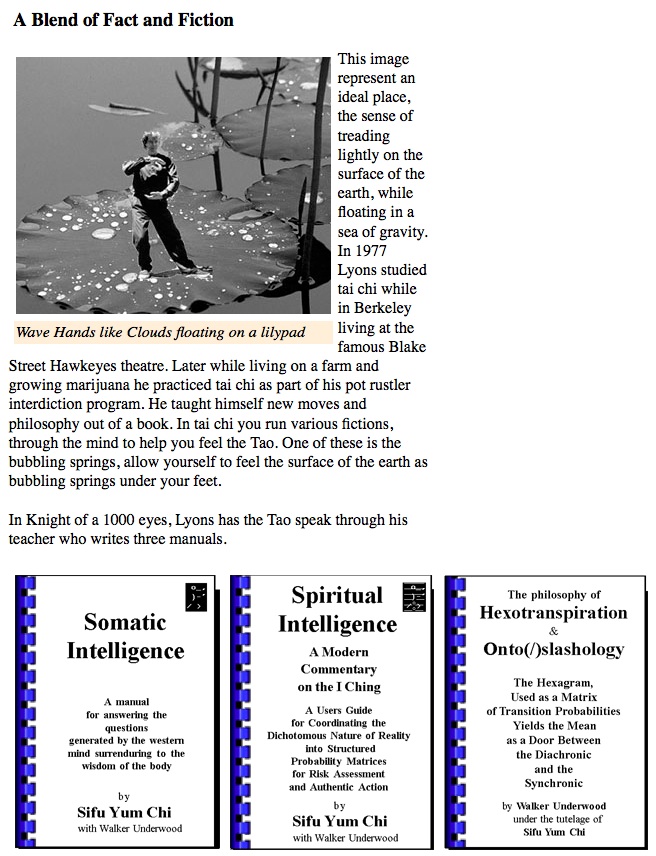
This page shows the idea of the narrator character Walker coming under the tutelage of a sifu. In chapter 3 “Yum Chi of the Phlung HI! School Chinese Butt-kicking”, there is a humorous story about the origin, Walker talks about being visited by, or how he came to create by active imagination, a kind of spirit guide he called Yum Chi. He felt like it was embedded in the “text” of the Long Form. In time Yum Chin and Walker collaborate on three instruction manuals. These are made distinct in the novel with the use of the “comb binding” graphic in the spine. Walker was practicing tai chi out in the field, and when he could feel what the form was asking him to do, and what if felt like to do it, it was as though the instruction was coming from a real sifu, though it was just a figment of Walker’s imagination. This sifu was way more than an martial arts teacher, it was what is referred to in the old Vedic texts as guru, not a person but a divine guiding energy that can come to be contained in a real spiritual teacher.
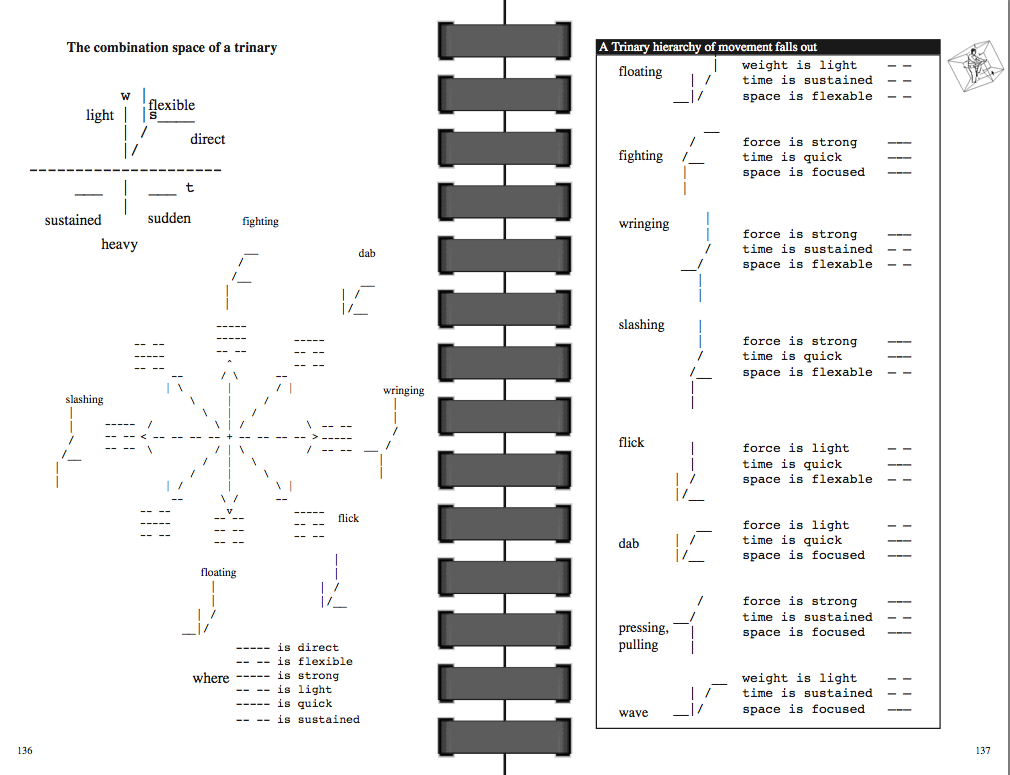
This page shows the mapping of the space of three attributes of movement Weight, Space and Time. This is the basis of Labanotation a notation for dance movement. This development is part of the second frame of learning tai chi, called the Lively Frame, and it suggests the journeyan at play exploring, because he knows the movements now, the variosuways in which he fan feel hismsel,, or the kinds of attacks, or how he can change the action of the movement from one form to the next.
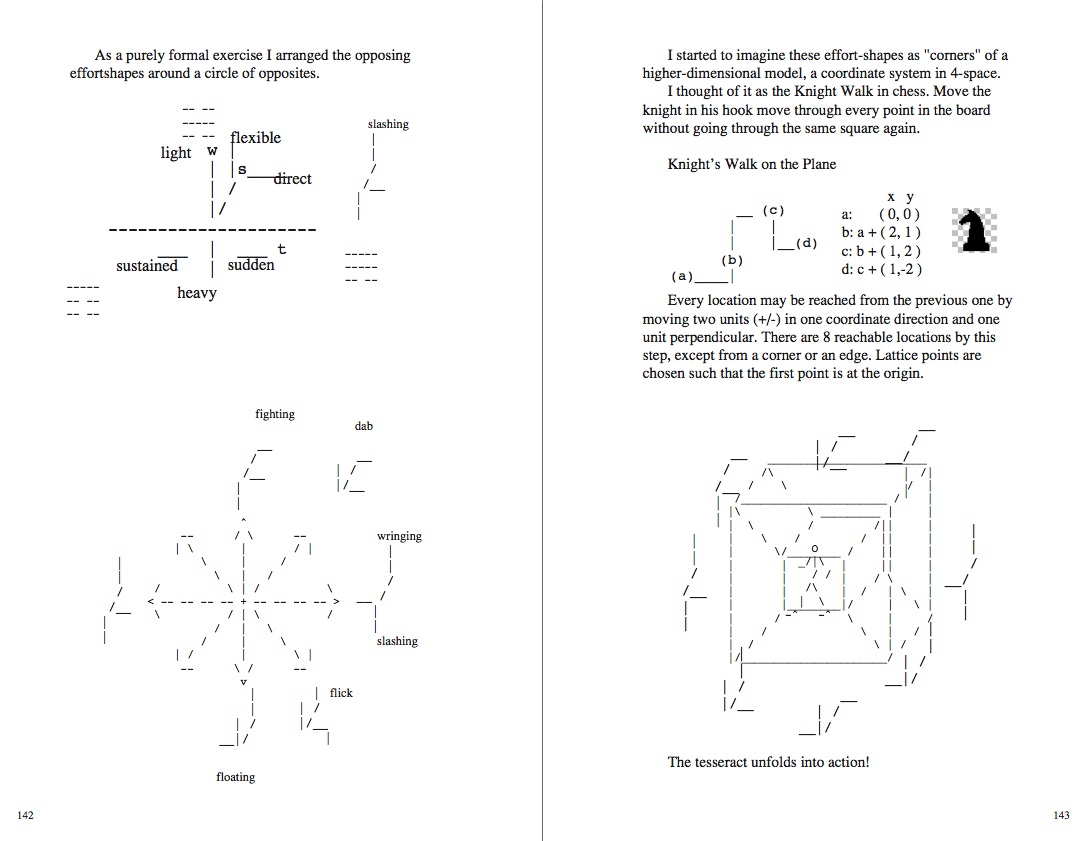 This image shows the reality matrix of the self, that sequence of sense, memory, desire feeling and thought that constructs our reality — as a tesseract, the simplest 4 dimensional object. It shows the basic four functions SNTF sensing intuiting thinking feeling in combinations building out on axes of comparison of functions taken two at a time. This leads to 16 combinations and these amplified with the Attention of inverted and extroverted and the perceptive and judging lead to the 64 combinations. We have the cardinality of the hexagrams.
Page showing chapter 78 from the manual Spritual Intelligence.
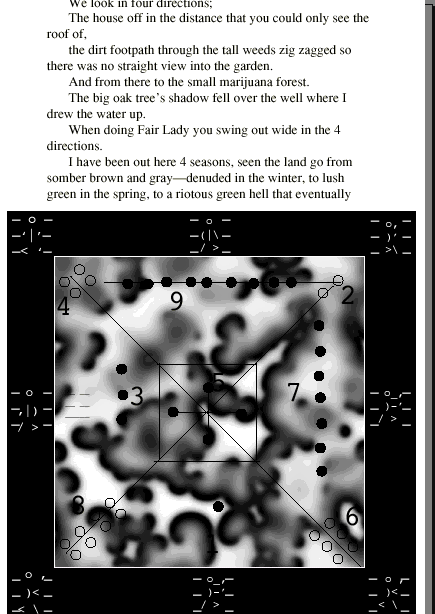
Thoughts while doing Fair Lady Works at Shuttles
Thoughts while doing Fair Lady Works at Shuttles This image shows the reality matrix of the self, that sequence of sense, memory, desire feeling and thought that constructs our reality — as a tesseract, the simplest 4 dimensional object. It shows the basic four functions SNTF sensing intuiting thinking feeling in combinations building out on axes of comparison of functions taken two at a time. This leads to 16 combinations and these amplified with the Attention of inverted and extroverted and the perceptive and judging lead to the 64 combinations. We have the cardinality of the hexagrams.
Developing analogy between G. Spencer Brown's Laws of Form and the forms of Tai Chi.
| 